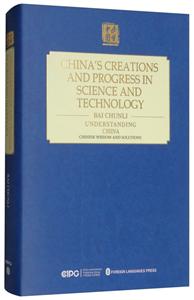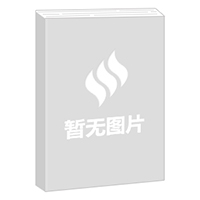-
>
論中國
-
>
中共中央在西柏坡
-
>
同盟的真相:美國如何秘密統(tǒng)治日本
-
>
中國歷代政治得失
-
>
中國共產黨的一百年
-
>
習近平談治國理政 第四卷
-
>
在慶祝中國共產主義青年團成立100周年大會上的講話
Chinas creations and progress in science and technology 版權信息
- ISBN:9787119114910
- 條形碼:9787119114910 ; 978-7-119-11491-0
- 裝幀:一般膠版紙
- 冊數:暫無
- 重量:暫無
- 所屬分類:>>
Chinas creations and progress in science and technology 本書特色
這本書系統(tǒng)闡述中國科學技術從古代興盛,經歷近代落伍,到當代走向復興的宏大歷程。作者以典型案例展現中國古代做出的重大發(fā)明創(chuàng)造,介紹近代中國怎樣受到世界科技革命浪潮的影響,勾畫出新中國自20世紀50年代以來向科學進軍、以科技為*生產力、實施創(chuàng)新驅動發(fā)展戰(zhàn)略的壯闊圖景,解讀了國家現代化建設中的科技進步與創(chuàng)新,前瞻新時代的科技創(chuàng)新大勢。這本書是從科技的傳統(tǒng)和變革的獨特視角,解讀中國的發(fā)展及民族偉大復興的一部佳作。
Chinas creations and progress in science and technology 內容簡介
《中國科技的創(chuàng)造與進步(英文)》系統(tǒng)闡述了在世界科技革命背景下,近現代中國科技的衰落與振興,作者用客觀的手筆刻畫出當代中國向科技進軍的壯闊圖景,展現我們如何以科技進步與創(chuàng)新,助力中華民族偉大復興事業(yè)。 《中國科技的創(chuàng)造與進步(英文)》同時也對國家發(fā)展科技的戰(zhàn)略部署,以及中國科技的未來發(fā)展,進行了適當的解讀。 《中國科技的創(chuàng)造與進步(英文)》可以稱之為對外解讀中國科技發(fā)展詳實的一部著作。
Chinas creations and progress in science and technology 目錄
Chapter 1 China's Creations
Section 1 Sophisticated and Ingenious Farming and Weaving Techniques
Section 2 Exploitation of the Works of Nature
Section 3 Architectural Constructions in China
Section 4 Investigating Things to Exhaust Heavenly Principles
Section 5 Traditional Chinese Medicine and Pharmacy
Chapter 2 Spreading of Western Learning to the East
Section 1 Smelting Materials of Alien Source
Section 2 Learning the Strengths of Alien People
Section 3 Laying the Foundation of Modern Science in China
Chapter 3 Marching Toward Science
Section 1 Building a Modern Scientific and Technological System
Section 2 Planning on Science and Technology
Section 3 Technological Progess and Industrialization
Chapter 4 Reform and Innovation of the Scientific and Technological System
Section 1 Spring of Science
Section 2 Reform of the Scientific and Technological System
Section 3 Technology Introduction and Innovation
Section 4 Exploring the Unknown
Chapter 5 Innovation-Driven Development
Section 1 Innovative Development Concepts and Strategy
Section 2 From an Innovative Country to a World Power in Scientific and Technological Innovation
Section 3 Roadmap of Scientific and Technological Development in Important Areas by 2050
Section 4 New-Type Scientific Research System
Afterword
Chinas creations and progress in science and technology 節(jié)選
《中國科技的創(chuàng)造與進步(英文)》: The traditional Chinese calendar is a lunisolar calendar, namely a calendar that takes the solar year as the basis of the length of a year and the synodic month as a month and adjusts the relation between seasons and months by setting leap months. In such a calendar, the correspondance between months and seasons has a certain range of disagreement, which can be nearly a month in maximum. In the beginning the 24 solar terms were determined in a year according to the position of the sun among the stars. This, in fact, is the part of solar calendar in traditional Chinese calendar. The 24 Solar Terms divide a tropical year into 24 equal intervals. Each term point is called a "JieQz" (pre-climate) or "ZhongQi" (mid-climate). Pre-climate and mid-climate are arranged in an alternating manner. Among them, pre-climates are State of Spring, Awakening of Insects, Clear and Bright, Start of Summar, Grain in Ear, Minor Heat, State of Autumn, White Dew, Cold Dew, State of Winter, Major Snow and Minor Cold; however, mid-climates include Rain Water, Spring Equinox, Grain Rain, Grain Buds, Summer Solstic, Major Heat, Limit of Heat, Autum Equinox, Frost Descent, Minor Snow, Winter Solstice and Major Cold. During the Southern and Northern Dynasties, astronomers discovered that the sun did not move evenly in the celestial background, so they modified the calculation of the 24 solar terms according to the actual position of the sun rather than simply divided a year's time into equal intervals. The 24 Solar Terms were mainly used to provide informauon for farming and became an integral part of tradiuonal Chinese culture. Many ancient Chinese poems take them as literary themes. Ancient Chinese astronomers divided the celestial sky into three enclosures or "Yuan" and 28 mansions or "X/u." The Chinese word Yuan means city walls. Three enclosures are in fact three celestial areas enclosed with "walls" carved out in the sky. The 28 mansions are 28 constellations. Such division method became mature in the Periods of Spring and Autumn and of Warring States. The 28 mansions and the North Celestial Pole were combined together to form an equtorial coordinate system in ancinet China. The position of any celestial body can be determined with "mansion-approaching degree" and "pole-departing degree." The 28 mansions were also grouped into four symbols, corresponding to four totems of the remote ancient Chinese peoples, respectively the Azure Dragon in the east, the White Tiger in the west, the Vermilion Bird in the south, and the Black Turtle in the north. For example, the Azure Dragon in the east includes seven mansions of Horn, Neck, Root, Room, Heart, Tail and Winnowing Basket. The term Three Enclosures appeared at the latest in the Sui (581-618) and Tang dynasties. These three enclosures were respectively Purple Forbidden, Supreme Palace and Heavenly Market. Due to the influence of the idea of the "unity between heaven and man," the arrangement and nomination of the celestial bodies in the sky corresponded with the human WOfld. For example, the enclosure of Purple Forbidden was a celestial area with the North CelesUal Pole as its center. It was regarded as the "imperial palace" in the heaven. In this enclosure, the "Emperor Star" corresponded to the emperor in the human world, "Empress Palace" to the empress in the human world and "Eight Grains" to the granary in the human world. The enclosure of the Supreme Palace was where the heavenly emperor and his ministers handled adminstrative matters. ……
Chinas creations and progress in science and technology 作者簡介
白春禮,1953年9月生,遼寧人。博士、化學家和納米科技專家。現任中國科學院院長、黨組書記、學部主席團執(zhí)行主席,發(fā)展中國家科學院院長。同時擔任中國科學院、發(fā)展中國家科學院、美國國家科學院、英國皇家學會、俄羅斯科學院等10余個國家科學院或工程院的院士。
- >
我與地壇
- >
唐代進士錄
- >
上帝之肋:男人的真實旅程
- >
中國歷史的瞬間
- >
龍榆生:詞曲概論/大家小書
- >
企鵝口袋書系列·偉大的思想20:論自然選擇(英漢雙語)
- >
羅曼·羅蘭讀書隨筆-精裝
- >
名家?guī)阕x魯迅:故事新編















